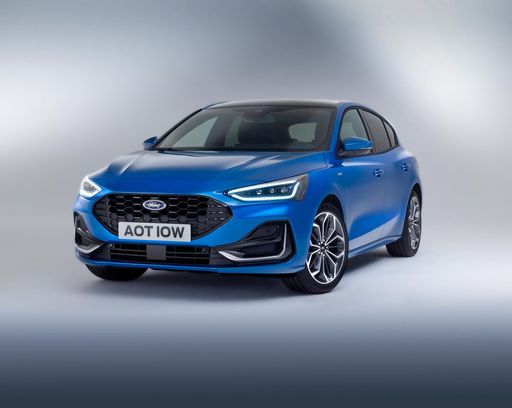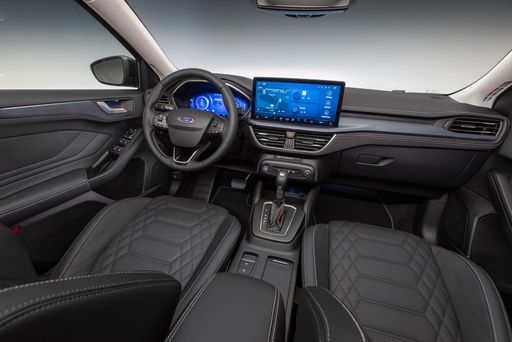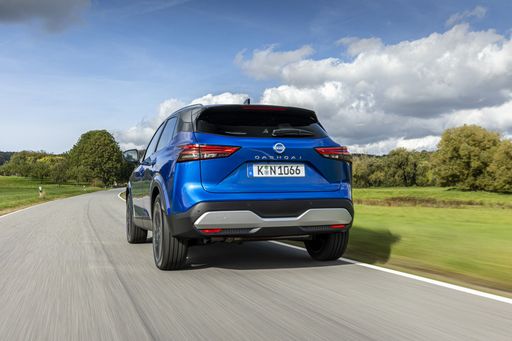The battle between the Ford Focus and Nissan Qashqai highlights a clash of automotive philosophies: one focusing on agile handling and driving pleasure, while the other emphasizes practicality and versatility. In this comparison, we will take a closer look at their technical specifications and innovations to see how they measure up against each other.
Ford Focus vs Nissan Qashqai – Which model is better for everyday use?
Two cars, one duel: Ford Focus meets Nissan Qashqai.
Which one wins in performance, efficiency and value for money? Find out now!
Design and Body Type
The Ford Focus is primarily a hatchback, celebrated for its sporty aesthetics and dynamic profile. It offers a compact yet spacious feel with a length ranging from 4382 mm to 4397 mm and a width of 1825 mm. The interior is designed for five passengers and provides a trunk capacity of 392 liters.
In contrast, the Nissan Qashqai is an SUV, exuding a more robust presence on the road. It measures 4425 mm in length and 1835 mm in width, also accommodating five passengers but boasting a larger trunk capacity of 504 liters. This configuration makes the Qashqai more suitable for families and those requiring more space for gear.
Engine Performance and Transmission
The Ford Focus offers a range of engine options, including petrol, diesel, and mild hybrid variants. Power outputs vary from 115 to an impressive 280 HP, alongside a good torque range between 170 Nm and 420 Nm, depending on the chosen engine. The Focus can accelerate from 0-100 km/h in as little as 5.7 seconds for the performance-oriented models. Fuel consumption ranges from 4.9 to 8 L/100 km, making it relatively economical for its class.
The Nissan Qashqai, on the other hand, features petrol MHEV and full hybrid engines, producing between 140 and 190 HP, with torque figures between 240 Nm and 330 Nm. The Qashqai can hit 100 km/h in as quickly as 7.9 seconds, with fuel efficiency ratings between 5.1 and 6.8 L/100 km. This makes the Qashqai a commendable choice for eco-conscious buyers.
Transmission and Drive Options
Ford offers diverse transmission options for the Focus, including manual and automated variants, such as dual-clutch automatic gearboxes. It is available only in front-wheel drive, emphasizing agility and control, ideal for urban driving conditions.
In contrast, the Nissan Qashqai provides both front-wheel and all-wheel drive options, enhancing its practicality and versatility for various road conditions. It features a manual gearbox and a continuously variable transmission (CVT), known for delivering a smooth driving experience.
Technology and Safety Innovations
Both vehicles come equipped with modern technology and safety features. The Ford Focus includes advanced driver-assist technologies such as adaptive cruise control, lane-keeping assist, and an intuitive infotainment system compatible with Apple CarPlay and Android Auto. Ford's Co-Pilot 360 safety suite further ensures driver confidence.
The Nissan Qashqai also boasts an array of innovative features, including the ProPILOT Assist system, which enables semi-autonomous driving capabilities. It incorporates advanced safety measures, such as automated emergency braking and blind-spot monitoring, ensuring a safe driving experience.
Final Thoughts
In summary, choosing between the Ford Focus and Nissan Qashqai boils down to personal preferences and lifestyle needs. If you're looking for sporty handling and a hatchback design with numerous engine choices, the Focus will likely appeal to you. However, if you require an SUV with practical space and hybrid options for better fuel efficiency, the Qashqai stands out as an excellent contender. Each car presents its strengths, making it crucial for buyers to assess their priorities carefully.
Here’s where it gets real: The technical differences in detail
Costs and Efficiency:
Price and efficiency are key factors when choosing a car – and this is often where the real differences emerge.
Ford Focus has a minimal advantage in terms of price – it starts at 27500 £, while the Nissan Qashqai costs 29600 £. That’s a price difference of around 2091 £.
Fuel consumption also shows a difference: Nissan Qashqai manages with 4.50 L and is therefore barely noticeable more efficient than the Ford Focus with 4.90 L. The difference is about 0.40 L per 100 km.
Engine and Performance:
Power, torque and acceleration are the classic benchmarks for car enthusiasts – and here, some clear differences start to show.
When it comes to engine power, the Ford Focus has a clearly perceptible edge – offering 280 HP compared to 205 HP. That’s roughly 75 HP more horsepower.
In acceleration from 0 to 100 km/h, the Ford Focus is distinct quicker – completing the sprint in 5.70 s, while the Nissan Qashqai takes 7.60 s. That’s about 1.90 s faster.
In terms of top speed, the Ford Focus performs a bit better – reaching 250 km/h, while the Nissan Qashqai tops out at 206 km/h. The difference is around 44 km/h.
There’s also a difference in torque: Ford Focus pulls clearly perceptible stronger with 420 Nm compared to 330 Nm. That’s about 90 Nm difference.
Space and Everyday Use:
Whether family car or daily driver – which one offers more room, flexibility and comfort?
Both vehicles offer seating for 5 people.
In curb weight, Ford Focus is barely noticeable lighter – 1330 kg compared to 1420 kg. The difference is around 90 kg.
In terms of boot space, the Nissan Qashqai offers noticeable more room – 504 L compared to 392 L. That’s a difference of about 112 L.
In maximum load capacity, the Nissan Qashqai performs hardly perceptible better – up to 1447 L, which is about 93 L more than the Ford Focus.
When it comes to payload, Ford Focus hardly perceptible takes the win – 560 kg compared to 520 kg. That’s a difference of about 40 kg.
Who comes out on top?
Overall, the Ford Focus shows itself to be leaves the rival little chance and secures the title of DriveDuel Champion.
It convinces with the more balanced overall package and proves to be the more versatile choice for everyday use.
 @ Ford Motor Company / Ford Media Center
@ Ford Motor Company / Ford Media Center
Ford Focus
Ford Focus
The Ford Focus remains a clever all‑rounder that balances sharp handling with everyday comfort, making it a strong choice whether your commute is city streets or country lanes. Its practical cabin and sensible running costs mean you’ll spend more time enjoying the drive and less time worrying about ownership, with a playful streak underfoot that keeps things interesting.
details @ Ford Motor Company / Ford Media Center
@ Ford Motor Company / Ford Media Center
 @ Ford Motor Company / Ford Media Center
@ Ford Motor Company / Ford Media Center
 @ Ford Motor Company / Ford Media Center
@ Ford Motor Company / Ford Media Center
Nissan Qashqai
The Nissan Qashqai blends practical, family-friendly packaging with SUV styling that refuses to shout, making it a sensible and dependable choice for everyday life. It’s comfortable to live with, economical on the road, and neatly equipped enough to feel modern without ever feeling precious — perfect if you want crossover versatility without the drama.
details @ Nissan Motor Corporation
@ Nissan Motor Corporation
 @ Nissan Motor Corporation
@ Nissan Motor Corporation
 @ Nissan Motor Corporation
@ Nissan Motor Corporation
 @ Nissan Motor Corporation
@ Nissan Motor Corporation
 @ Nissan Motor Corporation
@ Nissan Motor Corporation
 @ Ford Motor Company / Ford Media Center
@ Ford Motor Company / Ford Media Center
|
 @ Nissan Motor Corporation
@ Nissan Motor Corporation
|
|
|
|
Costs and Consumption |
|
|---|---|
|
Price
27500 - 42700 £
|
Price
29600 - 39900 £
|
|
Consumption L/100km
4.9 - 8 L
|
Consumption L/100km
4.5 - 6.8 L
|
|
Consumption kWh/100km
-
|
Consumption kWh/100km
-
|
|
Electric Range
-
|
Electric Range
-
|
|
Battery Capacity
-
|
Battery Capacity
-
|
|
co2
117 - 183 g/km
|
co2
102 - 154 g/km
|
|
Fuel tank capacity
52 L
|
Fuel tank capacity
55 L
|
Dimensions and Body |
|
|---|---|
|
Body Type
Hatchback
|
Body Type
SUV
|
|
Seats
5
|
Seats
5
|
|
Doors
5
|
Doors
5
|
|
Curb weight
1330 - 1529 kg
|
Curb weight
1420 - 1665 kg
|
|
Trunk capacity
392 L
|
Trunk capacity
479 - 504 L
|
|
Length
4382 - 4397 mm
|
Length
4425 mm
|
|
Width
1825 - 1844 mm
|
Width
1835 mm
|
|
Height
1438 - 1482 mm
|
Height
1625 mm
|
|
Max trunk capacity
1354 L
|
Max trunk capacity
1422 - 1447 L
|
|
Payload
495 - 560 kg
|
Payload
466 - 520 kg
|
Engine and Performance |
|
|---|---|
|
Engine Type
Petrol MHEV, Diesel, Petrol
|
Engine Type
Petrol MHEV, Full Hybrid
|
|
Transmission
Manuel, Automatic
|
Transmission
Manuel, Automatic
|
|
Transmission Detail
Manual Gearbox, Dual-Clutch Automatic, Automatic Gearbox
|
Transmission Detail
Manual Gearbox, CVT, Reduction Gearbox
|
|
Drive Type
Front-Wheel Drive
|
Drive Type
Front-Wheel Drive, All-Wheel Drive
|
|
Power HP
115 - 280 HP
|
Power HP
140 - 205 HP
|
|
Acceleration 0-100km/h
5.7 - 11.8 s
|
Acceleration 0-100km/h
7.6 - 10.2 s
|
|
Max Speed
186 - 250 km/h
|
Max Speed
170 - 206 km/h
|
|
Torque
170 - 420 Nm
|
Torque
240 - 330 Nm
|
|
Number of Cylinders
3 - 4
|
Number of Cylinders
3 - 4
|
|
Power kW
85 - 206 kW
|
Power kW
103 - 151 kW
|
|
Engine capacity
999 - 2261 cm3
|
Engine capacity
1332 - 1498 cm3
|
General |
|
|---|---|
|
Model Year
2022 - 2024
|
Model Year
2025
|
|
CO2 Efficiency Class
D, G
|
CO2 Efficiency Class
E, C
|
|
Brand
Ford
|
Brand
Nissan
|
What drive types are available for the Ford Focus?
Available configurations include Front-Wheel Drive.
The prices and data displayed are estimates based on German list prices and may vary by country. This information is not legally binding.
